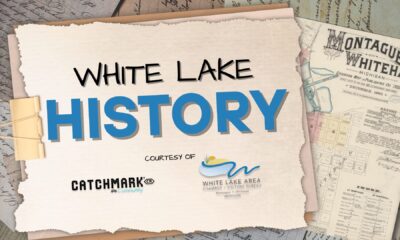
The White Lake Life Saving Station, established shortly after 1875, played a critical role in ensuring the safety of those navigating the waters near the north pier of the channel. Initially manned by a crew of seven or eight men, the station featured living quarters for the captain and sleeping quarters for the crew. Over time, additional small houses were constructed near the pier to accommodate the growing needs of the station.

Cutting Edge Technology
A unique feature of the station was an inclined runway built from the water to the station, facilitating the launching of boats. The station’s crew was diligent, patrolling the beach north and south of the pier with lanterns at night, ensuring the safety of the area.
An auxiliary building, often referred to as a large boat house, was situated a few hundred feet north of the south pier, near the edge of Lake Michigan. This white-painted structure housed a large life-saving boat, which was crucial during storms when navigating out of the channel became challenging. Initially, the boats were powered solely by oars, but later, inboard motors were introduced.
The south pier itself was a double-decker, designed for both pier-level walking and elevated walking during storms. A light was strategically placed at the west end of the pier to guide those navigating the waters.

Light Station Transition
In 1915, the station transitioned from using kerosene lights to electric lights, both at the lighthouse and at the end of the pier. This modernization was part of an ongoing effort to improve safety and efficiency.
Captain William Robinson served as the first lighthouse keeper from 1875 until 1915. He was succeeded by his son-in-law, William Bush, who served until the station’s closure in 1941. During this time, the lighthouse was not only a beacon for sailors but also served as living quarters for the keepers.

The station continued to evolve, with the lights being electrically operated and maintained by the Muskegon Coast Guard. Eventually, the lighthouse was sold to Fruitland Township for $6,250, with the intention of converting it into a museum. In 1946, the Coast Guard Station was put up for sale.
The End of an Era
R. John DeFraga took over as the White Lake Harbor Master for a period, utilizing a 36-foot lifeboat and a 26-foot surf boat, both designed to be self-bailing and self-righting. The original building was sold and relocated to the Holcomb lot, where it was replaced by a new residence built by Hallard Grover, a fisherman. Over time, this property was purchased by the Department of Natural Resources, and the City of Montague eventually acquired the area now known as Medbury Park.


The history of the White Lake Life Saving Station is a testament to the dedication and innovation of those who worked tirelessly to protect and serve the maritime community. Through various transitions and modernizations, the station remained a crucial part of the region’s history and heritage.
Research by W. L. Lipka.
Interactive White Lake History
As we deliver articles weekly, I challenge you to be curious, explore the local area, and take pictures at these historic locations, and tag CatchMark Community.
Next week we will explore the deserted village of White River. If you enjoy history and like our content please like and subscribe to our online resources. Also, check out the White Lake Area Historical Society website listed below.
http://www.whitelakeareahistoricalsociety.com/
https://www.facebook.com/CatchMarkCommunity
Brent is the Managing Partner of CatchMark Technologies and a seasoned technologist with over 25 years of experience in IT leadership, cybersecurity, and technical operations. He began his career serving in the U.S. Army, where he worked extensively with electronics—laying the foundation for his lifelong passion for technology and problem-solving. Brent holds a Certified Information Systems Security Professional (CISSP) certification and currently leads CatchMark’s Cybersecurity and Tech Support teams. Known for his strategic thinking and hands-on expertise, he excels in guiding secure, scalable solutions and driving innovation across complex technical environments.
Must See
-


Community
/ 1 hour agoStay Safe This Summer on Lake Michigan and White Lake
As summer heats up in the White Lake area, more people are heading to...
By Kara Raeth -


History
/ 20 hours agoWhite Lake History – Parades Through Time
The Tradition of Parades Parades have been a part of human celebration for thousands...
By Owen Raeth -


Community
/ 2 days agoCity of Whitehall Police Department Incident Report Summary Report Period: June 4 – June 17, 2025
Overview:Between June 4 and June 17, 2025, officers from the City of Whitehall Police...
By Kara Raeth











